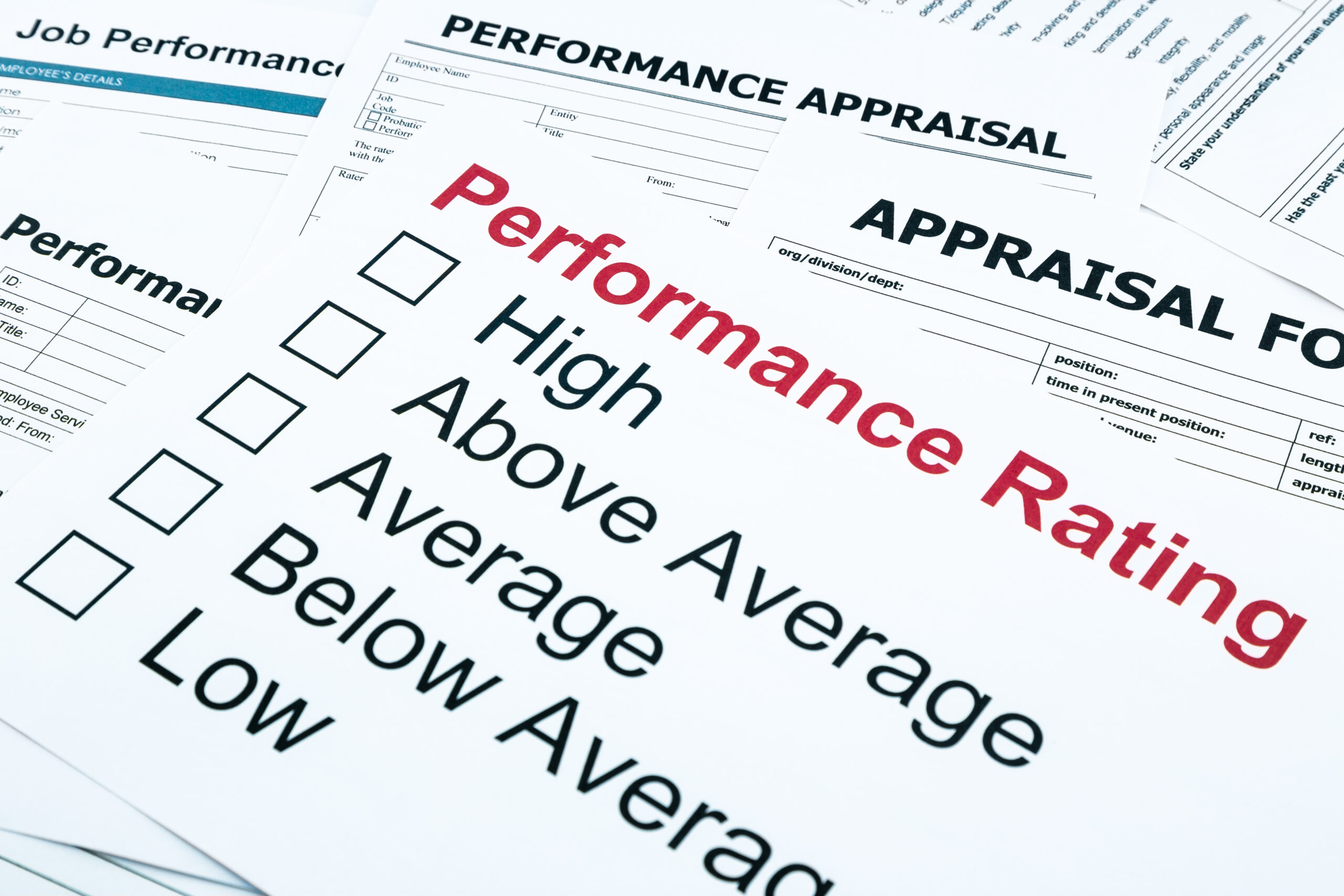
In recent years, the performance appraisal has undergone significant evolution. Gone are the days of rigid, one-sided assessments; today’s approach to work appraisals embraces a more holistic and collaborative model. As an employer, understanding the nuances of performance reviews, including 360-degree appraisals, is paramount for fostering growth and maximizing potential within your team. For employees these reviews provide valuable feedback on their job performance, set clear goals for improvement and development, and offer recognition for their contributions. Both parties gain a platform for open communication that can build engagement offer a path for advancement opportunities. Additionally, performance reviews contribute to a culture of accountability and alignment, ensuring that an individual’s goals are aligned with organizational objectives.
The Evolution of Performance Reviews

Traditionally, performance reviews were often dreaded events characterized by top-down evaluations, where managers assessed their subordinates’ performance based on predefined metrics. This uni-directional approach often left employees feeling demotivated and undervalued, leading to decreased morale and productivity.
However, the modern workforce demands a more inclusive and insightful approach to performance appraisal. Recognizing the importance of employee engagement and development, organizations have shifted towards 360-degree appraisals and more collaborative review processes.
In a workplace where organizations have to work hard to engage their teams, good communication between managers and workers is essential and the performance appraisal plays a critical role in staff retention. According to the people management platform, Reflektive,
“85% of American professionals would at least consider leaving a job after
an unfair job review; more than half are either “very likely” or “extremely likely” to do so. More than one-third of the group of 1,000 full-time workers said
the thing they are least likely to tolerate in the workplace is an inaccurate performance review. Another quarter of respondents believe they were
passed over for a promotion based on a review that did not accurately reflect their actual performance.”
How to Give a Performance Appraisal
Giving a performance appraisal requires careful planning and effective communication. Here’s a step-by-step guide for Managers giving a review:
- Preparation: Before the appraisal meeting, gather relevant data, such as performance metrics, project outcomes, and feedback from colleagues and clients. Review the employee’s job description, previous goals, and any developmental plans.
- Setting the Stage: Schedule a one-on-one meeting with the employee in a comfortable and private setting. Clearly communicate the purpose of the appraisal and encourage open dialogue.
- Feedback: Provide specific and constructive feedback based on observable behaviors and outcomes. Acknowledge achievements, address areas for improvement, and offer guidance on how to enhance performance.

Performance Appraisal - Goal Setting: Collaboratively set SMART (Specific, Measurable, Achievable, Relevant, Time-bound) goals for the upcoming review period. Ensure alignment between individual objectives and organizational goals.
- Developmental Support: Discuss opportunities for skill development, training, and career advancement. Encourage continuous learning and offer resources to support professional growth.
- Follow-Up: Schedule regular check-ins to monitor progress, provide ongoing feedback, and adjust goals as needed. Keep the lines of communication open and show genuine interest in the employee’s success.
The online career bootcamp, Simplilearn, has some good insight and questions for both sides of the appraisal desk. Employers and employees may benefit from viewing their guidelines.
Dealing with Employee Expectations
Employees expect performance appraisals to be fair, transparent, and meaningful. They want constructive feedback that helps them grow professionally, recognition for their contributions, and opportunities for career development. Additionally, employees value a collaborative approach where their input is solicited and valued.
Preparing a 360-Degree Appraisal
A 360-degree appraisal, also known as multi-rater feedback, provides a comprehensive view of an employee’s performance by gathering feedback from various sources, including managers, peers, subordinates, and clients. Here’s how to prepare a 360-degree appraisal:
- Identify Participants: Select individuals who have regular interactions with the employee and can provide valuable insights into their performance. This may include supervisors, colleagues from different departments, direct reports, and external stakeholders.
- Anonymous Surveys: Create customized survey questionnaires that capture different aspects of the employee’s performance, such as communication skills, teamwork, leadership, and problem-solving abilities. Ensure anonymity to encourage honest feedback.
- Collect Feedback: Distribute the surveys to selected participants and provide clear instructions on how to complete them. Set a deadline for submitting feedback to ensure timely completion.
- Compile Results: Collate the feedback from all participants and analyze the data to identify common themes, strengths, and areas for improvement. Look for patterns and discrepancies to gain a comprehensive understanding of the employee’s performance.
- Feedback Session: Schedule a feedback session with the employee to discuss the results of the 360-degree appraisal. Highlight key findings, celebrate achievements, and address any concerns or areas for development. Encourage open dialogue and collaboration in creating an action plan for improvement.

Performance Review Examples
Performance Review Examples
Performance reviews can be conducted by various individuals within an organization, depending on the company’s structure and practices. Typically, it involves input from both the direct manager and sometimes Human Resources (HR).
Additionally, formats may vary including written, oral, or a combination of both, depending on the organization’s preferences and practices. They are typically scheduled at regular intervals, such as annually or biannually, although some companies may opt for more frequent reviews, especially for new employees or during periods of significant change.
During a performance review, employees receive feedback on their job performance, discuss strengths and areas for improvement, set goals for future development, and often receive a rating or evaluation based on a predetermined scale or system. This evaluation scale may range from 1 to 10, with 1 representing poor performance and 10 indicating exceptional performance. Alternatively, organizations may use a different rating system, such as “meets expectations,” “exceeds expectations,” or “needs improvement.”
Here’s how performance reviews might be written for a data analyst with three years of experience and a medical assistant with one year of experience:
Data Analyst example:
“Sarah has demonstrated strong analytical skills and a deep understanding of our data systems throughout her three years with the company. Her ability to extract meaningful insights from complex datasets has been instrumental in informing strategic decisions. Sarah consistently meets deadlines and produces high-quality work. However, there is room for improvement in her communication skills during team meetings. Encouraging Sarah to share her insights more proactively will enhance collaboration and ensure that her contributions are fully recognized.”
Medical Assistant example:
“James has exhibited a strong commitment to patient care and professionalism in his role as a medical assistant. In his first year with us, he has quickly adapted to our clinic’s workflows and demonstrated proficiency in various administrative tasks. James shows promise in his clinical skills, but there is a need for further development in handling emergency situations. Providing additional training and opportunities for James to practice emergency protocols will bolster his confidence and preparedness in critical moments.”

What Happens if an Employee Disagrees?
Disagreeing with a performance review can be challenging, especially when an employee wants to maintain a positive relationship with their employer and ensure job security. However, there are constructive ways for employees to respond to feedback they disagree with without jeopardizing their position:
- Seek Clarification: If certain aspects of the performance review are unclear or seem inaccurate, it’s essential to seek clarification. Schedule a follow-up meeting with your manager to discuss specific points of contention and provide additional context or examples to support your perspective.
- Provide Evidence: If you believe that the feedback provided is unjust or based on inaccurate information, gather evidence to support your position. This could include performance metrics, project outcomes, or testimonials from colleagues or clients that contradict the assessment.
- Acknowledge Areas for Improvement: Even if you disagree with certain aspects of the performance review, it’s essential to acknowledge areas where you can improve. Express a willingness to address any concerns raised and outline steps you plan to take to enhance your performance moving forward.
- Offer Constructive Feedback: Use the performance review as an opportunity for a two-way dialogue. Share your thoughts on the feedback provided and offer constructive suggestions for how the appraisal process could be improved in the future. This demonstrates a proactive approach to problem-solving and a commitment to open communication.
- Focus on Solutions: Instead of dwelling on disagreements, shift the focus towards finding solutions and actionable steps for improvement. Collaborate with your manager to set clear, achievable goals and establish a plan for addressing any areas of concern identified in the performance review.
- Document Discussions: Keep a record of any conversations or correspondence related to the performance review, including points of disagreement and agreed-upon action plans. Having documentation can be valuable if you need to reference these discussions in the future.
- Stay Professional: Maintain a professional demeanor throughout the process, even if you feel frustrated or upset by the feedback received. Avoid becoming defensive or confrontational, as this can escalate tensions and hinder productive dialogue.
- Seek Support: If you’re unsure how to approach the situation or feel overwhelmed, consider seeking support from a trusted colleague, mentor, or HR representative. They can provide guidance, offer perspective, and help you navigate the process effectively.
By approaching the situation with professionalism, open-mindedness, and a focus on finding constructive solutions, employees can effectively respond to performance reviews they disagree with while safeguarding their position within the organization.
Overall, work appraisals play a crucial role in driving employee engagement, development, and organizational success. By embracing a collaborative and inclusive approach, employers can foster a culture of continuous improvement and empower their team members to reach their full potential. Through effective performance reviews, organizations can adapt to the changing needs of the modern workforce and thrive in today’s competitive business environment.

Are you finding yourself under-appreciated and communication with your manager difficult? Time for a new position?
Visit our Job Board to apply for one of our current searches.
Need Lloyd to Help You Hire?
If you have a current recruitment challenge that might benefit from a Lloyd search let us know. We will identify candidates who will meet your expectations and organization’s mission.
Complete our Request Talent query to launch your search and we will have one of our Lloyd recruitment professionals reach out to you.
Discover more from Lloyd Staffing
Subscribe to get the latest posts to your email.
